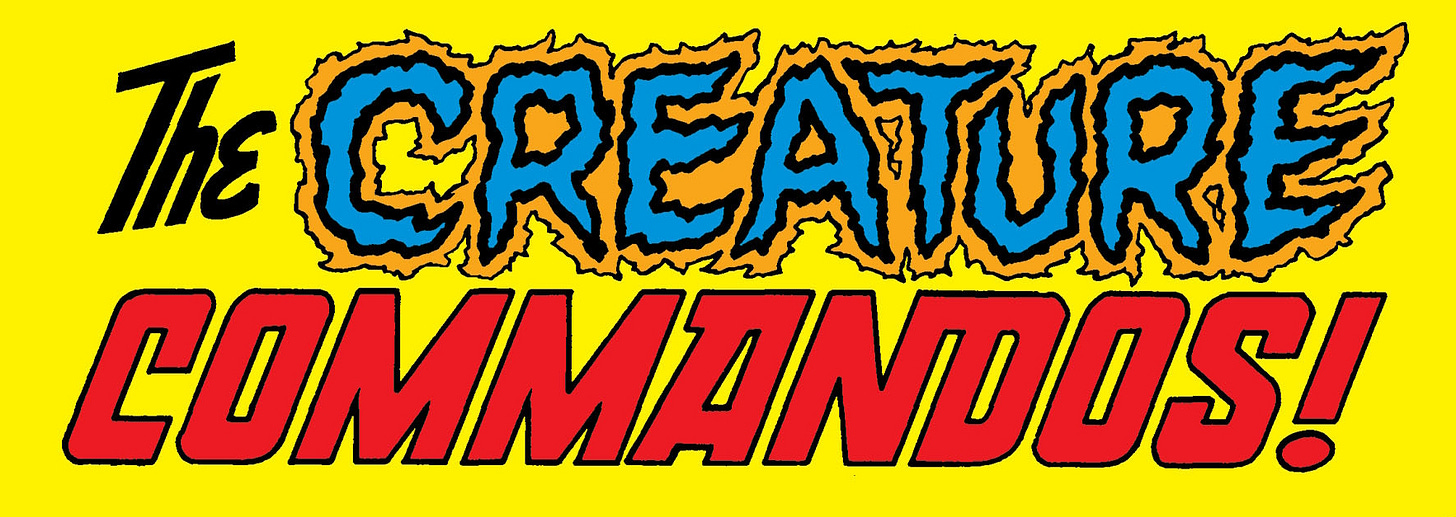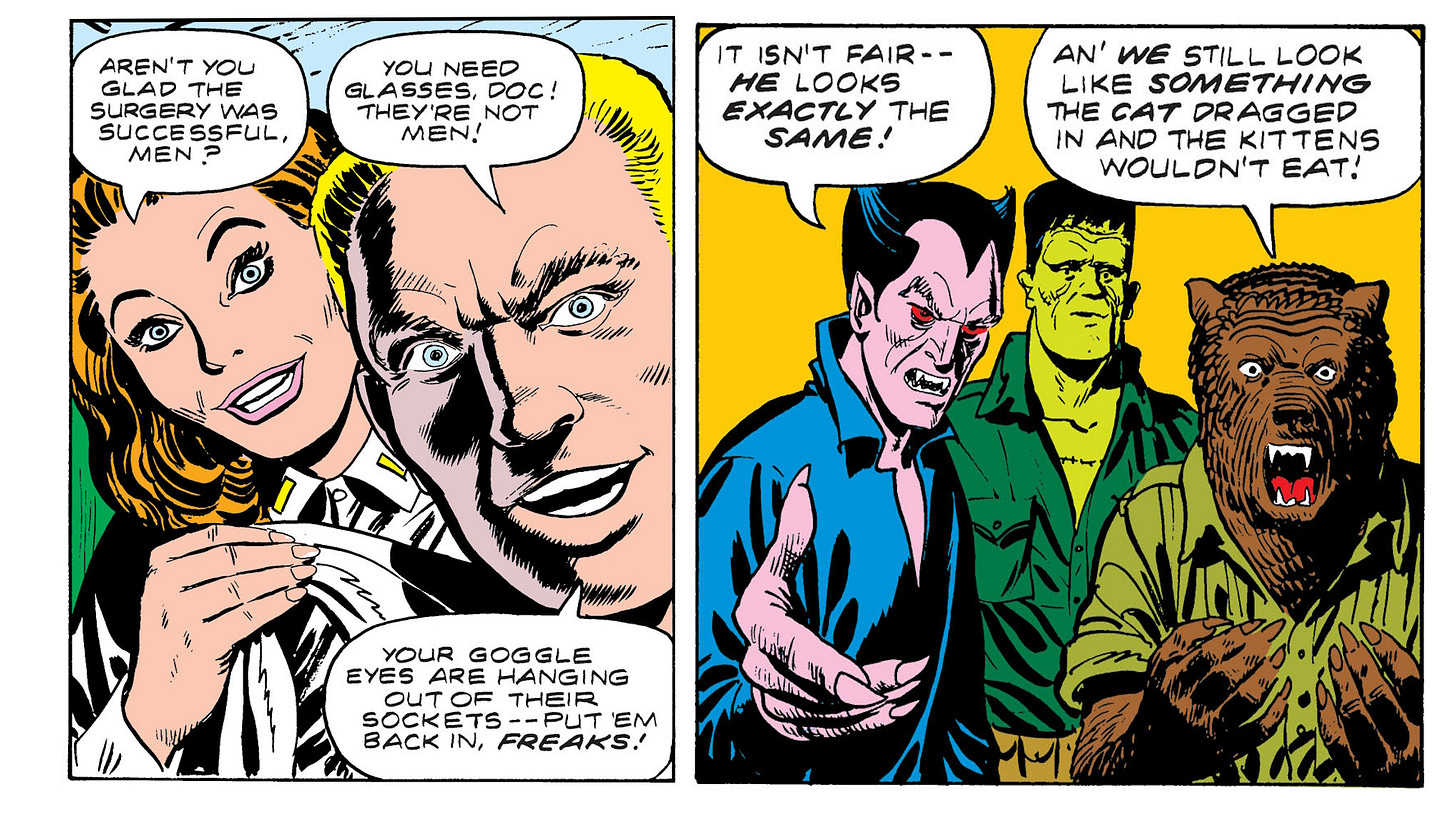Creature Commandos—appearance and toxic work environments
The job of a soldier in a war isn’t exactly safe, but the Creature Commandos are subjected to toxic environments by their superiors and the people their liberate.
The appearance of the Creature Commandos is tied into their effectiveness as weapons against the Axis forces in the Second World War.
When they are first introduced by Lieutenant Matthew Shrieve of U.S. Army Intelligence, Shrieve highlights the importance of the psychological battle almost the physical conflict. Project M for Monster is interested in harnessing the dark terrors of all people and weaponizing it against the enemy.
The three first Creature Commandos in the 1980 comic strip from Weird War Tales are representations of what Shrieve calls subconscious archetypes that are frightening regardless of social or culture backgrounds. In practice, they look like characters from 1930s horror films, a vampire, a werewolf and a Frankenstein’s monster.
Shrieve is completely correct. In their missions against the enemy, the Creature Commandos not only physically dominate larger numbers of enemy soldiers, but also terrify their opponents.
The fearsome appearance of the Creature Commandos is closely related to their effectiveness and their appearance has been crafted to perform a specific function.
The problem lies in the effectiveness of the Creature Commandos appearance and the assumptions made by everyone, including those the Creature Commandos liberate. After defeating an enemy and liberating a group of people, the Creature Commandos frequently find themselves shunned by the very people they have saved.
When the Creature Commandos are enjoying some leisure time, they cannot escape from the horrifying reality of their appearance. They visit the Chelsea Museum in London and see wax figures of historic villains only to be considered part of the exhibit. When the horrified public realises they aren’t wax figures, they run in terror. Even when the try and visit a circus of strange and unusual people, the Creature Commandos are rejected because the strange and unusual performs feel outclassed by the Creature Commandos.
If it wasn’t bad enough that both enemies and allies shun the Creature Commandos, the treatment of their superior officer, Lieutenant Shrieve, contemptable and undermining.
Shrieve consistently reminds the Creature Commandos of their shocking appearance. As a member of Project M, who has specifically crafted the appearance of the commandos, Shrieve is more than a little impressed with their appearance. Unfortunately, there is no distinction between Shrieve celebration of their horrific appearance and Shrieve’s derogatory comments. Consequently, Shrieve presents the Creature Commandos with a toxic environment.
The problems facing the Creature Commandos is further illustrated in a story named ‘A Mirror for Monsters’ by Robert Kanigher. As a result of a successful mission, the Creature Commandos and Shrieve find themselves being carried along by raging waters after destroying a dam.
Shrieve is horribly disfigured by the experience and despite his unpleasant behaviour, the Creature Commandos feel sympathy for him and overcome considerable odds to get him medical attention. Not only does Shrieve express no gratitude to the Creature Commandos, when he is taken into surgery, he tells the surgeon “patch me up so I won’t look like these freaks!”
As a result of the efforts of Doctor Myrna Rhodes, Shrieve makes a full recovery. When the Creature Commandos come to see him after months of recuperation, he looks exactly as he did before his injuries.
The Creature Commandos are shocked and confused. They ask Doctor Rhodes to operate on them, but she informs them their procedures are irreversible. As they leave the hospital in a rage, they inadvertently destroy a number of experimental chemicals that results in Doctor Rhodes being transformed into Doctor Medusa.
Being a skilled surgeon is no protection against the prejudice of others. With a head of live snakes, Doctor Rhodes can no longer practice medicine because her patients are horrified by her appearance. Doctor Rhodes’ response is one of outrage and anger which fuels her attack against a group of enemy infiltrators.
The treatment of the Creature Commandos by the enemy is intended. The treatment by the people they save is unfortunate, but the treatment of the Creature Commandos by Shrieve is nothing less than abuse.
The paradox of the Creature Commandos is to do their job they require a physical appearance that leaves them shunned and rejected by everyone outside of their small group. In the context of the Second World War, the Creature Commandos provide criticism of what it takes to win a war and the impact on those who gives their lives to protect others.
Support your local comic book store and pick up your copy of The Creature Commandos first set of stories from Weird War Tales.








